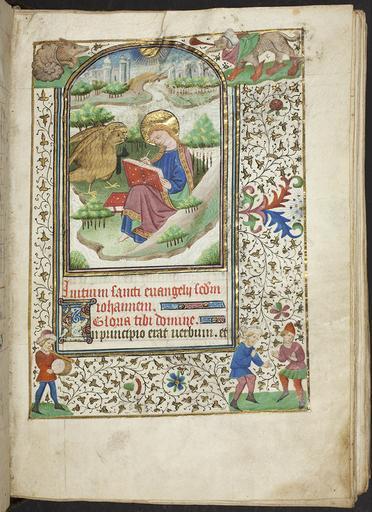MAKE A MEME
View Large Image

| View Original: | Book_of_Hours,_f.1r,_(184_x_133_mm),_15th_century,_Alexander_Turnbull_Library,_MSR-02..jpg (744x1024) | |||
| Download: | Original | Medium | Small | Thumb |
| Courtesy of: | www.flickr.com | More Like This | ||
| Keywords: indoor picture frame Copied in Eastern France between 1425 and 1475. On this leaf at the beginning of St John’s Gospel, is a miniature showing St John on Patmos. Traditionally John of Patmos, the author of the Book of Revelation, is also thought to be the same John who wrote the fourth gospel. The full ivy-leaf border includes grotesques along the top, with the lower border showing a man playing a drum and two men dancing. In the text underneath the miniature, a three-line initial ‘I’ opens the text (last line) for the phrase ‘In principio erat verbum’ (In the beginning was the word). The second and third lines above are completed by line fillers. The Book of Hours was a medieval prayer book used by laymen for private devotion. These books were created for both men and women, but their place in female devotion is particularly noteworthy. The text centres on the Hours of the Virgin, a series of prayers to be said at the eight canonical hours of Matins, Lauds, Prime, Terce, Sext, None, Vespers, and Compline. Copied in Eastern France between 1425 and 1475. On this leaf at the beginning of St John’s Gospel, is a miniature showing St John on Patmos. Traditionally John of Patmos, the author of the Book of Revelation, is also thought to be the same John who wrote the fourth gospel. The full ivy-leaf border includes grotesques along the top, with the lower border showing a man playing a drum and two men dancing. In the text underneath the miniature, a three-line initial ‘I’ opens the text (last line) for the phrase ‘In principio erat verbum’ (In the beginning was the word). The second and third lines above are completed by line fillers. The Book of Hours was a medieval prayer book used by laymen for private devotion. These books were created for both men and women, but their place in female devotion is particularly noteworthy. The text centres on the Hours of the Virgin, a series of prayers to be said at the eight canonical hours of Matins, Lauds, Prime, Terce, Sext, None, Vespers, and Compline. | ||||